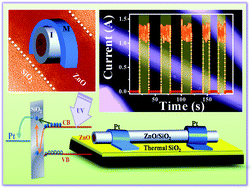Highly sensitive metal–insulator–semiconductor UV photodetectors based on ZnO/SiO2 core–shell nanowires†
Abstract
Highly sensitive metal–insulator–semiconductor (MIS) UV photodetectors are demonstrated based on ZnO/SiO2 core–shell

* Corresponding authors
a
Department of Materials Science and Engineering, National Tsing Hua University, Hsinchu, Taiwan ROC
E-mail:
ljchen@mx.nthu.edu.tw
Fax: +886-3-5718328
Tel: +886-3-5731166
Highly sensitive metal–insulator–semiconductor (MIS) UV photodetectors are demonstrated based on ZnO/SiO2 core–shell

 Please wait while we load your content...
Something went wrong. Try again?
Please wait while we load your content...
Something went wrong. Try again?
M. Afsal, C. Wang, L. Chu, H. Ouyang and L. Chen, J. Mater. Chem., 2012, 22, 8420 DOI: 10.1039/C2JM30514C
To request permission to reproduce material from this article, please go to the Copyright Clearance Center request page.
If you are an author contributing to an RSC publication, you do not need to request permission provided correct acknowledgement is given.
If you are the author of this article, you do not need to request permission to reproduce figures and diagrams provided correct acknowledgement is given. If you want to reproduce the whole article in a third-party publication (excluding your thesis/dissertation for which permission is not required) please go to the Copyright Clearance Center request page.
Read more about how to correctly acknowledge RSC content.
 Fetching data from CrossRef.
Fetching data from CrossRef.
This may take some time to load.
Loading related content
